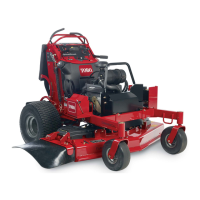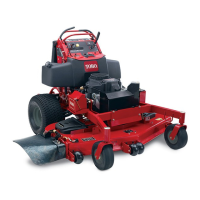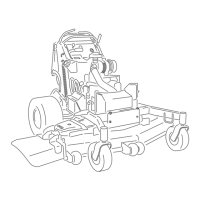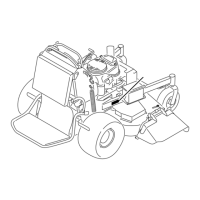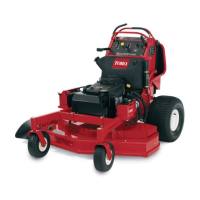21
1
2
3
1868
Figure 18
1. Oil dipstick
2. Metal end
3. Filler tube
Changing and Draining the Oil
1. Start the engine and let it run five minutes. This warms
the oil so that it drains better.
2. Park the machine so that the drain side is slightly lower
than the opposite side to ensure that the oil drains
completely. Then disengage the PTO, set the parking
brake, stop the engine, and remove the ignition key.
3. Open the hood.
4. Place a pan below the oil dipstick/fill tube and remove
the drain plug (Fig. 19).
5. When the oil has drained completely, install the drain
plug.
Note: Dispose of the used oil at a certified recycling center.
6. Change the oil filter, if necessary; refer to Changing the
Oil Filter, page 21.
7. Slowly pour approximately 80% of the specified
amount of oil into the filler tube (Fig. 18). Check the oil
level; refer to Checking the Oil Level, page 20. Slowly
add additional oil to bring the level to the Full mark on
the dipstick.
1
2
1869
Figure 19
1. Oil drain plug 2. Oil dipstick/fill tube
Changing the Oil Filter
Replace the oil filter every 100 hours or yearly, whichever
occurs first.
1. Drain the oil from the engine; refer to Changing and
Draining the Oil, page 21.
2. Remove the old filter and wipe the filter adapter
(Fig. 20) gasket surface.
3. Apply a thin coat of new oil to the rubber gasket on the
replacement filter (Fig. 20).
1
2
3
1256
Figure 20
1. Oil filter
2. Gasket
3. Adapter
4. Install the replacement oil filter to the filter adapter.
Turn the oil filter clockwise until the rubber gasket
contacts the filter adapter, then tighten the filter an
additional 1/2 to 3/4 turn (Fig. 20).
5. Fill the crankcase with the proper type of new oil; refer
to Checking the Oil Level, page 20.

